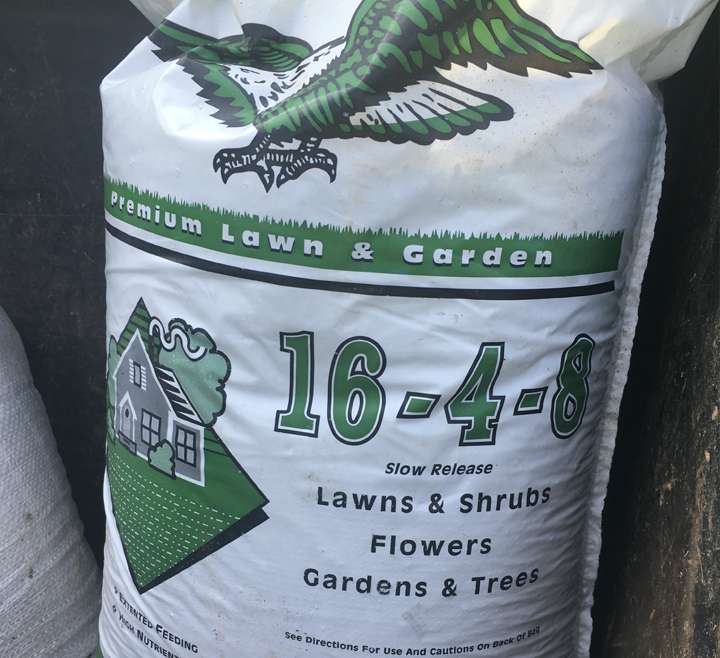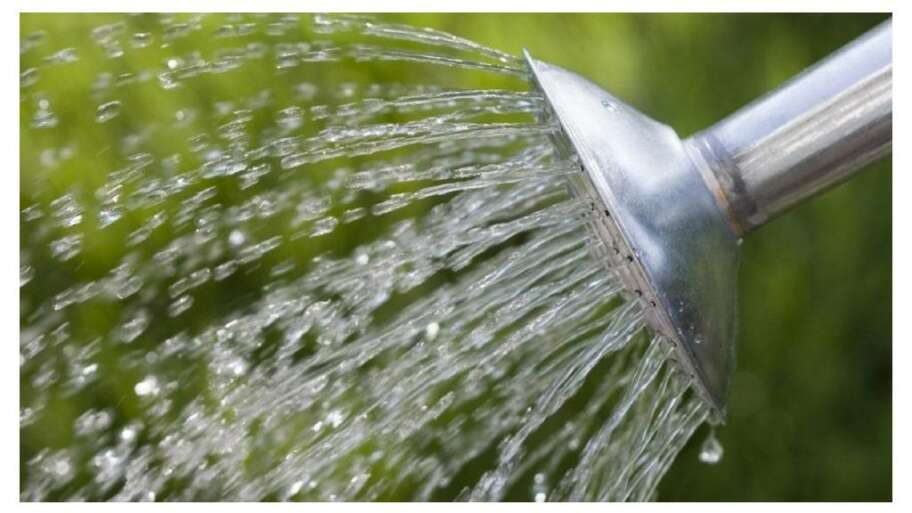All fertilizer labels must have three bold numbers. The first number designates the amount of nitrogen (N), the second number designates the amount of phosphate (P2O5), and the third number is the amount of potash (K2O). These three numbers represent the primary nutrients (nitrogen (N) – phosphorous (P) – potassium (K).
This label, known as the fertilizer grade, is a national standard.
A bag of 10-10-10 fertilizer, therefore, contains 10 percent nitrogen, 10 percent phosphate and 10 percent potash. This is referred to in the industry as a 1-1-1 ratio. A 16-4-8 would be a 4-1-2 ratio.
Two or more nutrient sources mixed together form a blend or a fertilizer grade. Blends will normally contain particles of more than one color. Manufacturers produce different grades for the many types of plants and for different soils.
There are also fertilizers that contain one of each of the primary nutrients. Nitrogen sources are liquid nitrogen (30-0-0), sodium nitrate (16-0-0), ammonium nitrate (33.5-0-0) and urea nitrogen (46.0-0) among others. Phosphorus is provided as 0-46-0 and potash as 0-0-60 or 0-0-50.
CALCULATING NUTRIENTS
If you have a 50-lb of fertilizer the nutrients could be calculated by multiplying 50 times .10 for each nutrient. Thus a 50-lb bag of 10-10-10 would contain 15 lbs of nutrients or 5 lbs of nitrogen, 5 lbs of phosphorous and 5 lbs of potash. The remaining weight is filler usually either sand or granular limestone. Be aware the limestone is ground to the consistency of small grit and does not have a liming effect.
To calculate the nutrients in a 40-lb bag of 16-4-8 you would multiply 40 times .16 giving you 6.40 lbs of nitrogen, 40 times .04 giving you 1.6 lbs of phosphorous and 40 times .08 would give you 3.20 lbs of potash or a total of 11.20 lbs of nutrients in the bag.
SELECTING A GRADE
The best way to select a grade is to have a soil test. The test report will recommend a fertilizer grade for your use. The report will come with a management note that provides guidelines for supplementing nitrogen for lawn and garden crops.
The available grades are almost endless. Some typical grades are:
10-10-10 – This is an excellent grade for gardens. Poor for lawns.
16-4-8– This is an excellent grade for lawns not for gardens.
28-4-8– An excellent grade for lawns in cooler weather.
46-0-0– Excellent for lawns in cold weather.
Fertilizer grades are really not the important factor. What is important is to make sure you get enough nutrients on the lawn. A nice lawn needs 4 to 5 lbs per 1000 sq. ft. of nitrogen per year. Ideally about 4 lbs of this should be applied in the fall in about three applications. If you need help ask.
SPREADING FERTILIZER
I am sure that at some point you have seen a yard with yellow and green stripes. This was likely caused by spreading fertilizer the wrong way. The fertilizer must be spread evenly to avoid striping. The most popular types of spreaders are drop spreaders or cyclone spreaders. Personally, I strongly recommend the cyclone. When you spread the fertilizer make sure you overlap your spread patterns. I like to lap almost back to my tire tracks. An even better way if you have time is to spread half the fertilizer in one direction and half in the other direction, checkerboard fashion.
If you have questions about which grade of fertilizer to use, ask and we will be glad to help. We prefer not to offer advice on fertilizer purchased at other stores, as we are not familiar with their products.
FERTILIZER NUTRIENTS
THE THREE PRIMARY PLANT FOODS
NITROGEN:
- Gives dark green color to plant.
- Promotes increased leaf and stem growth.
- Adds crispness and improved quality to leaf crops.
- Produces rapid early growth.
- In small amounts, hastens maturity.
- In excessive amounts, may delay maturity.
PHOSPHORIC ACID:
- Stimulates early root formation and growth.
- Gives rapid and vigorous start to plants.
- Hastens maturity of crops.
- Is especially important in seed formation.
- Increases the ration of grain and fruit to stalk.
- Gives hardiness to fall-seeded grains and hays.
POTASH:
- Gives increased vigor to plants.
- Helps plants to resist disease.
- Produces strong stiff stalks.
- Promotes production of sugars, starches and oils.
- Increases plumpness of grains and seed.
- Improves quality of the yield.
THE THREE SECONDARY PLANT FOODS
CALCIUM:
- Increases the stiffness of stalk.
- Improves general plant vigor.
- Encourages grain and seed production.
- Neutralizes poisons produced in the plant.
- Regulates uptake of other plant foods.
- Promotes early root formation and growth.
- Hastens maturity.
SULFUR:
- Gives increased root growth.
- Helps maintain dark green color.
- Promotes nodule formation on legumes.
- Stimulates seed production.
- Encourages more vigorous plant growth.
MAGNESIUM:
- Aids in maintaining dark green color of leaves.
- Acts as a carrier of phosphoric acid in the plant.
- Promotes the formulation of oils and fats.
- Regulates uptake of other plant foods, especially calcium.
- Plays a part in the translocation of starch.
MICRONUTRIENTS:
BORON:
- Aids in cell wall formation.
- Sugar transport in plants.
- Helps in flower retention and pollen formation.
- Aids in germination.
- Low boron will reduce seed and grain formation.
COPPER:
- Necessary for carbohydrate and nitrogen metabolism.
- Aids in cell wall formation.
- Helps reduce wilting.
IRON:
- Aids in production of chlorophyll.
- Aids in nitrogen reduction and fixation.
- Iron in conjunction with sulfur helps catalyze other reactions.
MANGANESSE:
- Necessary for photosynthesis.
- Aids in nitrogen metabolism and other compounds necessary for plant metabolism.
- Low manganese may delay maturity in some crops.
MOLYBDENUM:
- Involved in enzyme systems relating to nitrogen fixation with legumes.
- Nitrogen and sulfur metabolism are affected by molybdenum.
- Has a significant effect on pollen formation.
ZINC:
- Essential for energy production,
- Aids in protein synthesis and growth regulation.
CHLORIDE:
- Most of its functions relate to salt effects.
- Indirectly affects plant growth by stomatal regulation of water loss.
WARNING—too much chlorine may be more harmful than not enough.
Be aware that most soils contain adequate amounts of micronutrients. They are usually required in very small amounts. I have only seen two or three deficiencies of micronutrients in over 40 years of dealing with fertilizer. Deficiencies can only be diagnosed by a lab.




